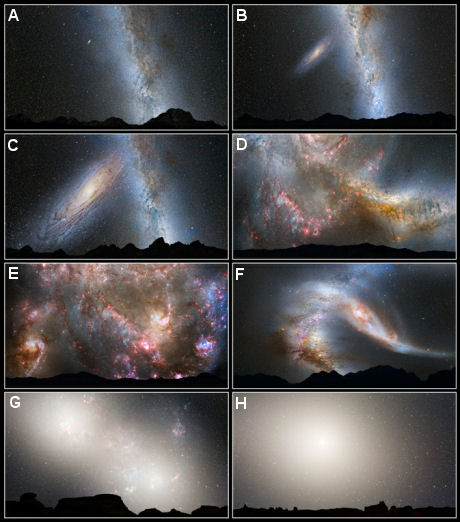1 June 2012
Andromeda-Milky Way collision visualized
by Will Parker
After nearly a century of speculation about the future destiny of Andromeda and our own Milky Way galaxy, scientists at NASA have visualized what the eventual collision of the two galaxies will look like and where our own solar system will end up.

A century ago astronomers did not realize that Andromeda was a separate galaxy far beyond the stars of the Milky Way. Astronomer Edwin Hubble measured its vast distance by uncovering a variable star that served as a "milepost marker." Hubble went on to discover the expanding universe where galaxies are rushing away from us, but it was established early on that Andromeda is moving toward the Milky Way at about 250,000 miles per hour.
Andromeda is around 2.5 million light-years away, but it is inexorably falling toward the Milky Way under the mutual pull of gravity between the two galaxies and the mysterious dark matter that current astronomical models suggest surrounds them both.
Predicting the outcome of the galactic encounter was made possible thanks to painstaking Hubble measurements of the motion of Andromeda (also known as galaxy M31). The measurements show the galaxies will plow into each other in 4 billion years time, but astronomers say the stars inside each galaxy are so far apart that they will not collide with other stars during the encounter. However, the stars will be thrown into different orbits around the new galactic center. Simulations show that our solar system will probably be tossed much farther from the galactic core than it is today.
To complicate matters, M31's small companion, the Triangulum galaxy (M33), will join in the collision and perhaps later merge with the M31/Milky Way pair. There is a small chance that M33 will hit the Milky Way first.
The simulation derived from Hubble's data show that it will take an additional two billion years after the encounter for the interacting galaxies to completely merge under the tug of gravity and reshape into a single elliptical galaxy similar to the kind commonly seen in the local universe.

A: Present day.
B: In 2 billion years the Andromeda galaxy is noticeably larger.
C: In 3.75 billion years Andromeda fills the field of view.
D: In 3.85 billion years the sky is filled with new star formation.
E: In 3.9 billion years, star formation continues.
F: In 4 billion years Andromeda is tidally stretched and the Milky Way becomes warped.
G: In 5.1 billion years the the Milky Way and Andromeda appear as a pair of bright lobes.
H: In 7 billion years the merged galaxies form a huge elliptical galaxy.
"In the worst-case-scenario simulation, M31 slams into the Milky Way head-on and the stars are all scattered into different orbits," said team member Gurtina Besla, of Columbia University. "The stellar populations of both galaxies are jostled, and the Milky Way loses its flattened pancake shape with most of the stars on nearly circular orbits. The galaxies' cores merge, and the stars settle into randomized orbits to create an elliptical-shaped galaxy."
Previously, it was unknown whether the encounter would be a miss, glancing blow, or head-on crash; the outcome depending on Andromeda's tangential motion. Until now, astronomers had not been able to measure this, but the Hubble team conducted extraordinarily precise observations of its sideways motion that remove any doubt that it is destined to collide and merge with the Milky Way. The Hubble observations are detailed in three papers that will appear in an upcoming issue of the Astrophysical Journal.
Related:
Discuss this article in our forum
Watch an animation of the collision
Hundreds of rogue stars found outside galaxy
"Fleeing galaxies" tracked deeper into universe
Cosmic Collisions - Watching Merging Galaxies in the Act
Source: NASA/Goddard Space Flight Center
Pics courtesy NASA; ESA; Z. Levay and R. van der Marel, STScI; T. Hallas, and A. Mellinger
